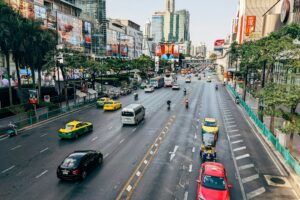Singapore broadband users will be looking at a brand new range of broadband services this week, when SingTel starts rolling out mobile broadband plans that promise “typical speeds” along with a “priority lane” for users on pricier plans to surf on the cyber highway.
Until now, all broadband plans here – and in most parts of the world – are sold according to the promised top speeds that are hardly reached in everyday use because of factors like network congestion and wireless coverage.
SingTel said as much today when it launched its first-of-its-kind services. Executive vice president of digital consumer, Yuen Kuan Moon, pointed to the many users who have complained that they never got the speeds they paid for, especially when mobile networks are clogged with 145 per cent cellphone penetration in Singapore.
SingTel’s answer? Give priority to those who pay more, and try to let them know what speeds they will typically get.
Launched today, the new service plans are aimed at 3G dongle users. Those paying more for the 7.2Mbps (S$40 a month) and 21Mbps (S$59.90) plans now will be given a “separate lane” when all the lanes on a cyber highway are congested. However, dongle users on the cheaper 3.6Mbps (S$29.90) plan will not get any priority; nor will smartphone users.
| Mobile broadband plan | Theoretical speed | Typical speed range* |
| Classic 3.6 | 3.6Mbps | 0.8Mbps to 2.1Mbps |
| Priority 7.2 (with Priority Pass) | 7.2Mbps | 1.4Mbps to 3.7Mbps |
| Premium 21 (with Priority Pass) | 21Mbps | 1.7Mbps to 4.8Mbps |
Are you clearer now?
Besides this priority lane, the other bit of news here is the disclosure of “typical speeds”. Let’s give SingTel credit for trying to give users some transparency, even before the government regulator starts mandating a standard for disclosure.
The typical speeds that SingTel will advertise are well within its capabilities, said Moon today, because it has measured these speeds to be deliverable right now for about 80 per cent of the time, islandwide.
But take this with a pinch of salt and don’t expect your downloads to be always as fast as what’s on paper. Reason: what’s typical for one user is most likely not typical for another. Moon acknowledges this himself and says there isn’t a list of top 10 sites that people go to here but more like 100 sites, which they cannot all cater for.
That’s why SingTel cannot provide a “typical” speed that users will definitely get when they surf to, oh, a Tudou or YouTube or CNN.com. And that’s why the typical speed promise here still does not really reflect what every user will get on the go.
Plus, this speed that SingTel is referring to is for an FTP download from its own servers. How can that be representative of typical speed when most of its users probably don’t download stuff from its SingTel servers?
Yet another problem with defining a “typical” speed here is that content providers often throttle how fast you can download from their sites. Try downloading from a Download.com server at peak US times, for example, and see if you can get the minimum 1.4Mbps that SingTel seems to promise on its mobile broadband plans. The answer is clearly no.
To be fair, you have to praise SingTel for providing more information, but in the short term, at least, this information may just end up generating more grouses from people, who will now complain: “hey, how come my download from my favourite site is below your typical speed?”
Sadly, the same folks who complained about false advertising based on “top speeds” will not have any clearer a picture with SingTel’s “typical speeds” if these speeds are achieved with tests that are atypical of what users usually use their broadband for.
That’s basically the crux of the issue, which unfortunately, the new plans don’t solve. Instead, more education is needed, to have consumers understand that the Internet is very much like a regular highway, and you basically are subject to jams here and there, from time to time, despite the top speeds or typical speeds advertised.
That’s also why SingTel, or any other telco, won’t compensate you if your download speeds fall below what they promise. But then, what do you expect when you pay less than S$50 a month for a link that connects to everywhere in the world, including many sites where your telco has no control over speed (a website owner may have a slow link to the Net, for example)?
Is this anything new?
What’s good is that SingTel’s plans do offer priority for those who pay more. By at least guaranteeing a fast link to its servers, it is also reserving enough capacity to connect to a base station – the main problem for clogged 3G networks rather than raw speed – for heavy users who are willing to pay.
So, in a congested area, say, at the CBD at noon, you can expect to have “right of way” and have things faster than the other user who has paid less (all things being equal and if the website you’re downloading from supports the faster speed).
I’d be surprised if telcos here facing the explosion of mobile broadband have not already been shaping their traffic to “reward” those who pay it more and ensure these customers stay on. But again, kudos to SingTel for openly telling its users what it’s doing.
There will still be limitations, of course. Will SingTel be able to guarantee “right of way” when so many of them log in, say, at last week’s PC Show, where thousands of people turned up at the same time? Will SingTel be able keep up its speed guarantee by upgrading its cell sites and adding capacity – which take planning and setting up – as more people sign up for its “priority” plans?
SingTel has said it will do its best. Which means, essentially, we are back to where we began – you still have to trust your service provider to be able to provide what it promises on paper.
In terms of competition, I think the heat will be on operators to provide better service now that they are promising “typical speeds”, no matter if these speeds are actually achieved. I’d expect M1 and StarHub to publish so-called typical speeds as well.
But in terms of transparency, you fear that the term would end up being used just as loosely as the “top speed” terminology that people seem to be so unhappy about. When “typical speeds” are something you realise you can’t get often, you’d lose faith in its accuracy as well.
To be honest, the problem is not all the telcos’. Having had broadband here since the 1990s, Singapore users should also be finding out more about how the Net works. Basically, if someone promises that you can surf at a “typical speed” at the price we are paying for and with current technology, you’d better ask him how he’s doing it.
Yes, there are highly-expensive and legally-binding SLAs (service level agreements) drawn up between companies and telcos to link up regional offices, for example, that promise uptime and speed, but these links cost in the thousands or tens of thousands of dollars and yes, they are typically for links between specific places and not to all the online venues on the Net (because your telco cannot control your download speeds to some sites).
This is not to say that we broadband users should just buy a service based on faith. Rather, there should be more sophisticated tests that give a “snapshot” of what users get each month, for example.
The Infocomm Development Authority (IDA) already carries out some tests for home broadband services, and it’d be better if users could get that information on all these new mobile broadband plans launched today and in the future. It’d be better if the IDA expanded its tests to represent more practical tasks that users perform.
All this will still just be “representative”, of course. There is just no single “typical speed” that can be advertised on a brochure that will give you an 100 per cent accurate picture of what you’d be getting. Just like you can’t tell exactly how fast you’d travel on the CTE or PIE, it’d be tough to know exactly how fast you’d get on the cyber highway.
If speed really matters to you, it pays to do some homework. The hope is that the IDA will provide more clarity from independent surveys it can carry out on users’ behalf, say, on download speeds to the most popular sites that users go to, or to a random list of sites that it decides are important. This way, users can check out service providers before they sign up to a binding two-year plan.






what singtel is trying to do is to differentiate between users like me (and I suspect just about anyone reading this too) who are freeloading by tethering to my smartphone and users who are paying for another mobile broadband line for their laptop/tablet. Once you see it this way it all makes sense why SingTel is launching Priority Pass. whether or not it actually means faster throughputs is of secondary concern to the telcos. I have a commentary on pg 2 of Digital Life today if u are keen to read more
@Ripoff – that’s a stupid analogy, and i think you know it too. the car analogy implies you have a choice of how and when to use to full capacity, when you actually don’t.
it’s well-known (if you’ve not been hiding in a cave last 5 years) that internet speeds are dependent on variable factors, some of which are completely outside the telcos’ control.
even if you have LTE speeds, it’s not going to change your download speeds from Download.com during peak US hours.
/ac
Let’s keep life simple and call a spade a spade.
If I sell you a car of top speed 210km/h and you can only drive it at 17km/h to 48km/h, there is no other word to call it than ripoff.